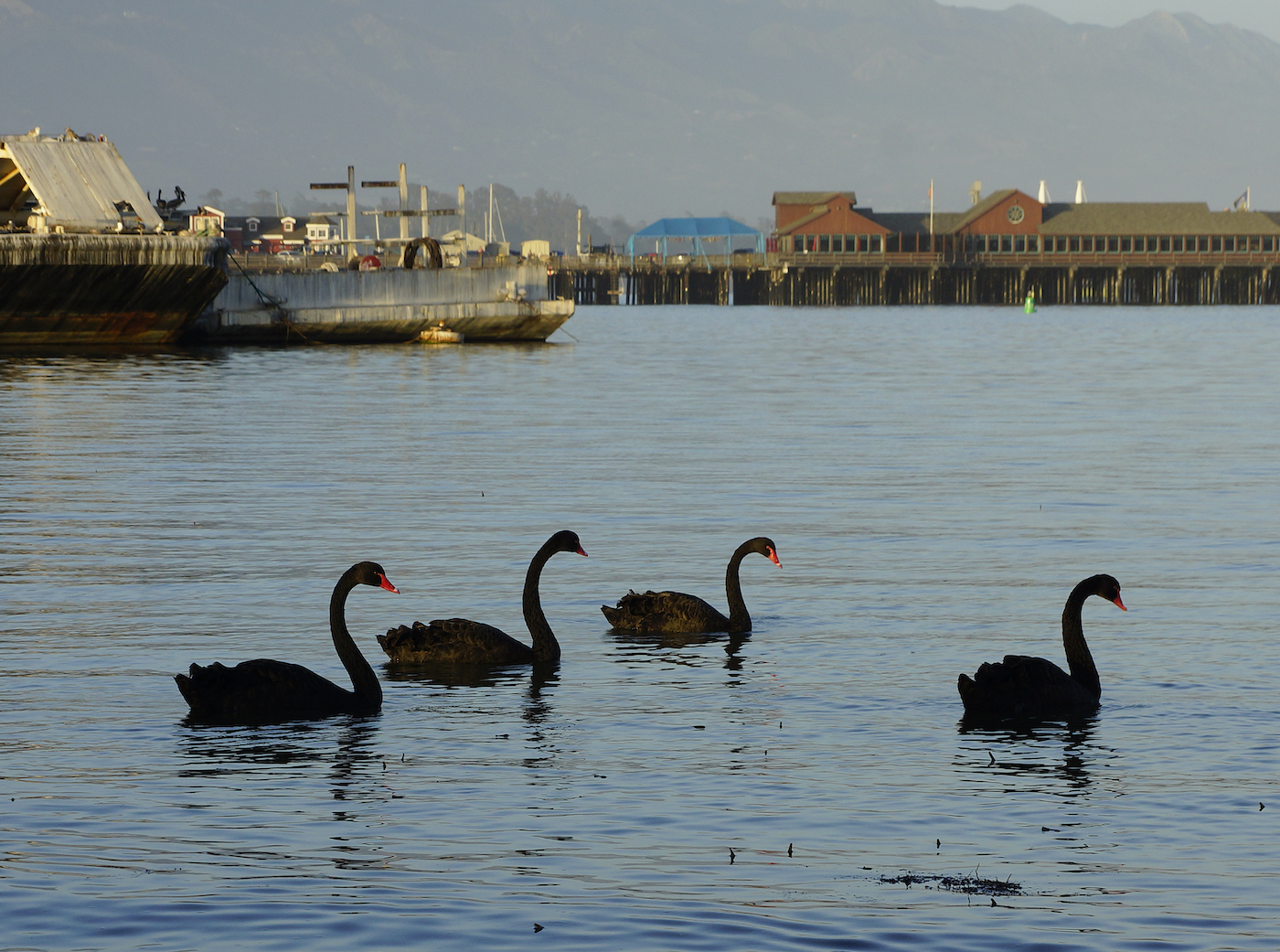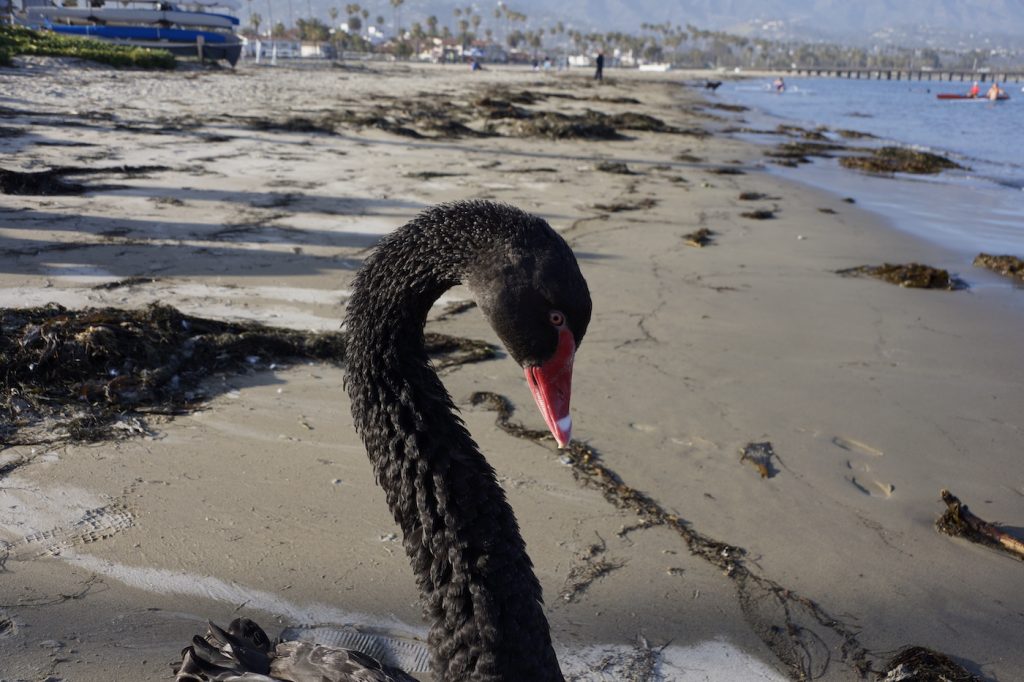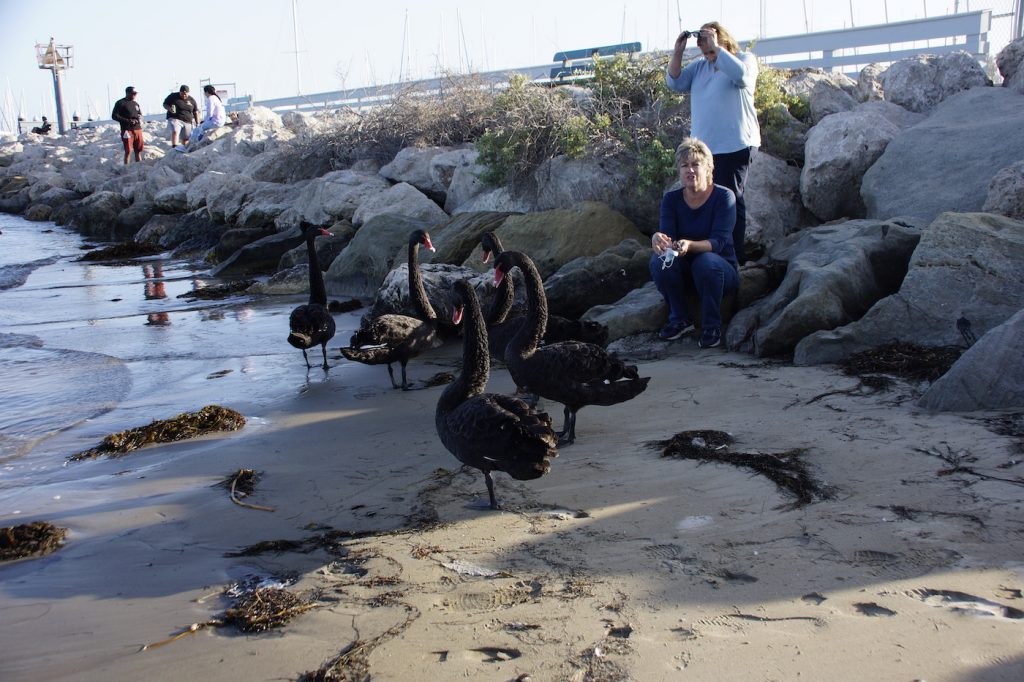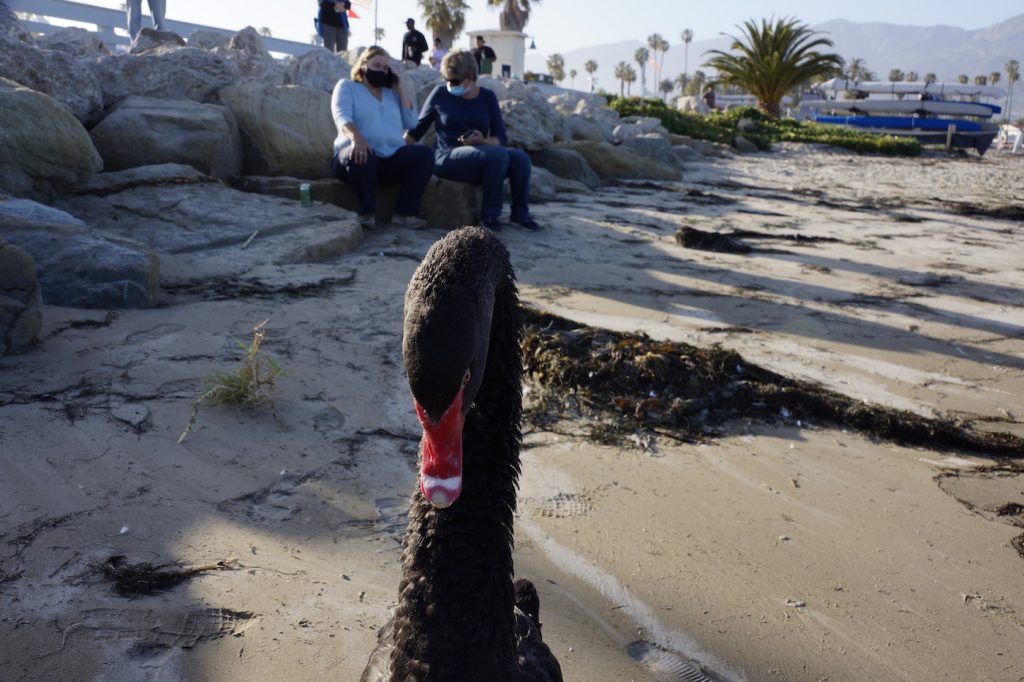Black Swans: Chaos Surrounds Discovery and Ultimate Capture of Black Swans in SB Harbor

The phones at both the Santa Barbara Wildlife Care Network and Santa Barbara Zoo were quite busy over the weekend and into Tuesday — there were a handful of Australian Black Swans hanging out in the Santa Barbara Harbor, a sight never seen on the South Coast.
That ended abruptly on Tuesday afternoon when Julia Di Sieno, the executive director of the Animal Rescue Team, led a small rescue mission and captured the five black swans in crates — an action that will now permanently keep them in captivity. The scene was a chaotic one, as conflicting instructions led to some demanding that the black swans be left alone, while Di Sieno and her group believed the rescue effort was necessary due to the Harbor water containing materials potentially harmful to the herd.
According to Julia Parker, the director of operations at the Santa Barbara Wildlife Care Network, advice from the California Fish and Wildlife Services originally indicated that the black swans should be left alone, potentially allowing them to migrate on their own. As more information became available about the birds, including fear that they could not fly after they didn’t attempt to escape capture, the decision to scoop them out of the water was made.
Both Parker and Di Sieno indicated that the birds did not show signs of distress, although Di Sieno was fearful that one would get injured or killed due to the heavy boat use in the area.

Post capture, the black swans were taken to the SBWCN facility in Goleta, where a veterinarian examined all five, with all in good health. They were subsequently released into Di Sieno’s custody, who had secured a private residence for them.
Parker joined Di Sieno at the private property, with the owner telling SBWCN officials that they wanted to remain anonymous. A private party must have a permit in order to own a black swan, although it wasn’t immediately known whether that one had been secured in this instance.
According to Pam Bierce of the U.S. Fish & Wildlife Service, black swans are not protected under the Migratory Bird Treaty Act, which would have prohibited “the taking (including killing, capturing, selling, trading, and transporting) of protected migratory bird species without prior authorization” by the USFWS.
The black swan is not endangered, with a global population estimated at 500,000.
Sifting Through Misnomers

In an exclusive video viewed by the Montecito Journal, one of the activists could be heard justifying the capture due to black swans being freshwater birds — which is not the case, as they can be found in both fresh and seawater.
Native to both Australia and New Zealand, black swans are not common in the United States, although the Santa Barbara Zoo does have one and it is still accounted for. The species has also been introduced in England and Japan, among other countries.
The five swans were seemingly friendly, with Roger Chrisman, whose yacht Polaris is parked in the Harbor, saying:
“They are just amazingly beautiful. Majestic. And they’re very, very friendly. They come right up to you. Gotta be somebody’s pets. We are giving them fresh water from the back of our yacht.”
The fact that a crowd of people did not scare off the black swans was another factor in the decision to capture them. Under normal circumstances, the species is well-equipped to defend itself.
“They can break your leg if they spread their wings; they know how to protect themselves,” Parker said.
Prior to those found at the Harbor, there were reports of finding black swans in Lake Forest, Newport Beach, and Irvine in 2020, according to the Orange County Register.
Parker indicated that this ballet of swans had been seen recently in that same area, although the possibility of it being the same herd did cause officials to initially push the pause button on removing them from the Harbor waters.
Upon examination by the SBWCN vet, the black swans had not been clipped, a process that eliminates the ability to fly off. This is normally done every eight weeks and will need to be done by the new owner.
According to Parker, black swans usually like to remain in a particular environment, becoming comfortable in a specific habitat, which makes the scene at the Harbor incredibly rare.
Rumors Run Rampant

With the idea that this herd might be the property of a local resident — which can’t be eliminated despite the lack of wing clipping — the rumor mill as to whom they might belong has grown exponentially each day.
Calls into the USFWS’ Ventura office about any potential permits along the South Coast were not immediately returned.
Regardless, rumors surrounding Oprah Winfrey being the owner were quickly debunked, according to Penny Bianchi.
There was a thought swirling they might belong to the owners of an estate along Hot Springs Road in Montecito, but that was untrue as well.
There was also scuttlebutt that black swans could be a royal pet, although it is unknown if Prince Harry and Meghan Markle have any on their Montecito estate.
In England, Queen Elizabeth II technically owns all of the unmarked mute swans throughout the country, a tradition dating back to the 12th century, when swans were a prized meal.
Now, swans are a protected species in the U.K., and there are steep criminal penalties for injuring or killing them, as well as jail time for stealing swan eggs.
Much Ado About the Black Swan
The black swan at the Santa Barbara Zoo has provided Rachel Ritchason, the zoo’s director of animal collections, a unique perspective on what to expect from the creatures that can be as tall as five feet and up to 20 pounds.
Santa Barbara’s temperate climate is a perfect match for the black swans’ needs, and the multiple bodies of water would have allowed the herd to travel around the area, with the water providing the opportunity to feed on algae and small bugs.
The black swan is monogamous and normally follows its mate, meaning that observers can plan to see two at a time in most cases. And, if they can’t be seen, they will be heard, as the species is quite vocal.
Even in the colder and wetter months, the black swan at the zoo has proven to not need any additional heat, while not hindered by the rain.
Ritchason was excited about having a front row seat to observe the black swan in its natural habitat, something that has no known precedent on the Central Coast, with additional sightings in San Francisco, Bakersfield, and San Diego.
The past few days have left both the zoo and SBWCN thankful that there is sincere interest in helping wildlife — with the black swan situation ultimately leaving all five alive and healthy.
“We live in a community that cares, and kudos to them for caring so much about these animals,” Ritchason said.





